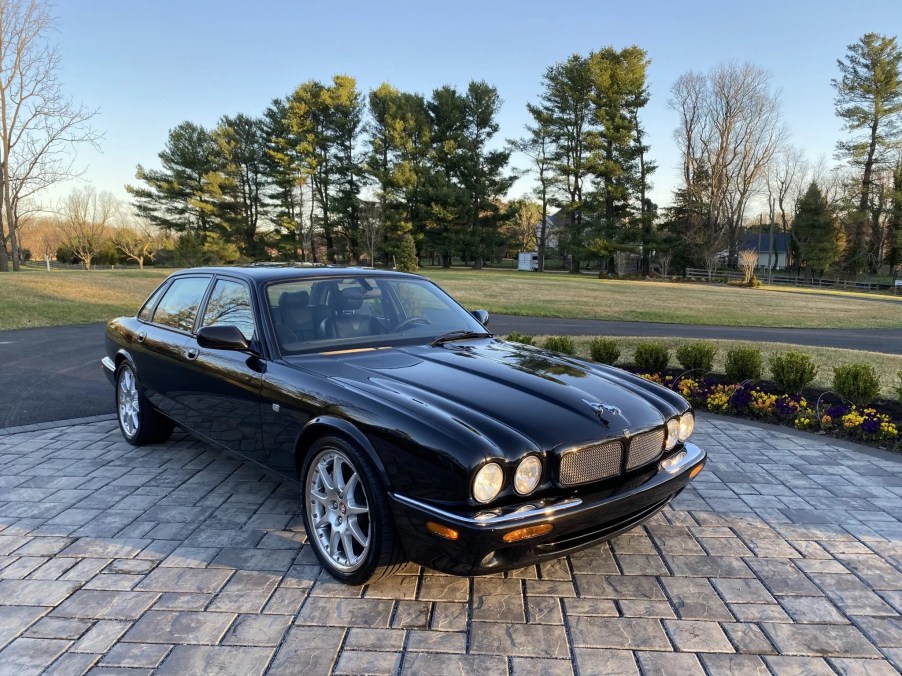
The Jaguar XJR 100 Celebrated a Centenary With Style and Speed
While its modern sedan lineup has shrunk recently, Jaguar has a long history with four-door luxury passenger cars. And many of them, like the Mk 2, favored by ‘60s cops and robbers, aren’t just comfortable, but genuinely sporty. Hence why the British brand’s old sales slogan was ‘Grace, Space, Pace.’ And in that regard, the X308 Jaguar XJR 100 fits right in.
An X308 Jaguar XJR combines “stately luxury with muscle car power,” MotorTrend says

Although it’s not currently in production, the Jaguar XJ is a long-lived nameplate, Car and Driver reports. First launched in 1968, the XJ was originally supposed to be the only Jaguar sedan, replacing the Mk X, the Mk 2, and the S-Type. And by 1998 it was in its sixth generation, known today as the X308, Automobile explains.
Design-wise, the 1998-2002 X308 Jaguar XJR looks similar to its predecessor, the X300. But that ‘8’ signifies the major change. While previous XJs used six-cylinder engines and V12s, the X308 XJ was the first Jaguar with a V8. Specifically, several V8s, MotorTrend explains, a 3.2-liter and a 4.0-liter. The US market only got the 4.0-liter V8 options, though. However, that also included the Jaguar XJR.
The X308 Jaguar XJR’s 4.0-liter V8 is supercharged. So, instead of 290 hp and 290 lb-ft, it makes 370 hp and 387 lb-ft. That goes to the rear wheels via a five-speed automatic and lets the XJR go 0-60 mph in 5.3 seconds, Car and Driver reports. And in 1998, that made it one of the fastest sedans available, AutoClassics reports.
Besides the V8s, the X308 XJs have several upgrades over the earlier X300. They have different interiors, upgraded and retuned suspension components, more airbags, and more accurate steering racks, MT reports. X308 models also have four-wheel ABS-equipped disc brakes, leather upholstery, automatic climate control, and power seats. And in 2000, traction control became standard on all models, Classics World reports.

The Jaguar XJR has several additional features. Besides sportier suspension and standard traction control, it has performance-rated tires, stability control, heated seats, and an upgraded audio system, MT reports. Plus, cross-drilled Brembo brakes were an optional extra. And, like the other X308 XJs, the XJR offered optional adjustable dampers.
The X308 Jaguar XJR 100 is a supercharged 100th birthday present to the brand’s founder

For 2002, the X308-gen car’s last year of production, Jaguar made it slightly more special. 2002 marked Jaguar founder Sir William Lyons’ 100th birthday, and to celebrate, the automaker released the limited-edition XJR 100. And suitably for a centenary gift, the limited-edition sedan came with all the bells and whistles.
Besides the standard XJR features, the 2002 Jaguar XJR 100 has the optional cross-drilled Brembo brakes and adaptive dampers, Autoblog reports. It also has trim-specific ‘anthracite’ paint, BBS wheels, and red-stitched charcoal leather sport seats. Plus, it has heated front and rear seats, a 6-disc CD changer, rear parking sensors, a sunroof, and navigation, Bring a Trailer and Forbes report.
But whether in standard or limited-edition 100 trim, the X308 Jaguar X308 makes for an excellent and overlooked used luxury car. Even with the sportier suspension, the sedan has “unwavering ride quality,” CarThrottle reports. And its supercharged V8 pulls the XJR forward with what Evo describes as “seemingly effortless grace.” It’s not quite as sharp as the contemporary M5, but it’s still great fun on twisty roads, Driving.ca reports.
In short, the X308 Jaguar XJR makes for a comfortable cruiser that can still sprint when the need arises. And the good news is, it’s easier to live with than you might think.
It’s an affordable, reasonably sporty luxury car that’s genuinely reliable
Jaguars don’t always have the best reputation for reliability, and the outgoing XJ had its fair share of problems. However, while the X308 XJ and XJR had some problems, by and large, they’re actually fairly dependable, PistonHeads reports.
Apart from worn suspension bushings and the odd failed adaptive damper, the X308 Jaguar models only have two major issues, Honest John explains. Early models’ Nikasil cylinder linings, much like those BMW engines used, couldn’t tolerate the high-sulfur unleaded gasoline used in the late ‘90s. Early-build X308 XJs also use plastic timing-chain tensioners that are prone to failure, Motorious reports, as are their water pumps.

Luckily, by 2000 Jaguar started using different cylinder linings and upgraded the tensioners and the water pump. And in 2002 it swapped the plastic tensioners for steel ones, Evo reports. The good news is all these parts are compatible with the early-build cars. And once they’re replaced, the X308 Jaguar becomes “a thoroughly dependable car,” Motorious reports.
It’s also a fairly inexpensive used car. True, XJR 100s command a premium, because production was capped at 500 models and the US only got 240. But most X308 models on Bring a Trailer hover in the $10,000-$15,000 range.
Follow more updates from MotorBiscuit on our Facebook page.


